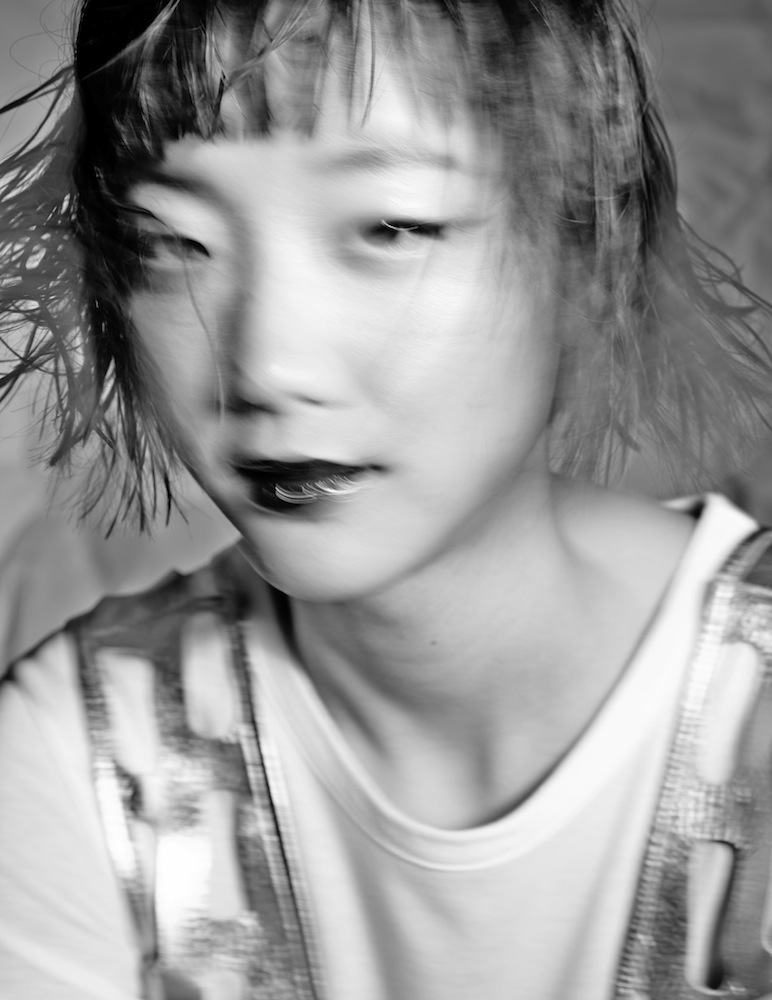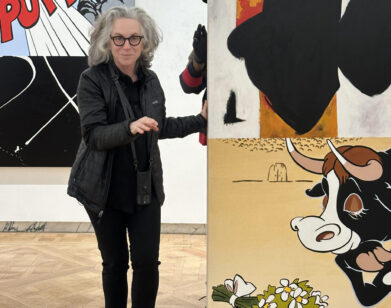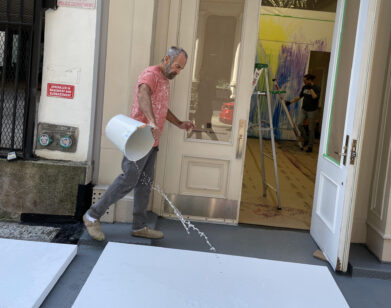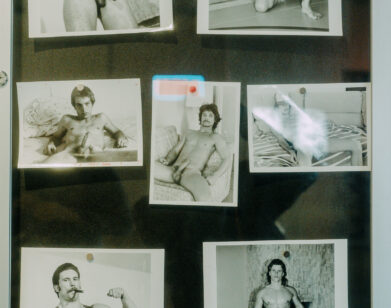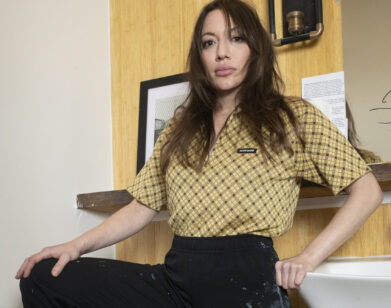The Aural Artist
CHRISTINE SUN KIM IN LONDON, NOVEMBER 2015. PHOTOS: ROBERT BELLAMY. STYLING: NATLIE BREWSTER. HAIR: FEDERICO GHEZZI/W-M MANAGEMENT. MAKEUP: EMILY MERGAERT USING MAC COSMETICS AND RADICAL SKINCARE.
Upon walking into a small room at MoMA PS1, visitors are given Lucite boxes that are filled with complex wiring and have two-foot tall antenna-like protrusions. Hanging overhead are three taught wires covered in blue Velcro. The goal is to continuously walk while keeping the antenna touching the Velcro, triggering magnetic sensors along the way. When doing so, a robotic voice begins to speak and the faster one walks, the faster the voice talks. Walking backward inverts the vocal output. Although the task seems simple, maintaining contact between the antenna and wire is a frustrating endeavor—and as soon as the two are disconnected, the audio restarts. This feeling of frustration and defeat, however, is exactly what sound artist Christine Sun Kim wants to elicit with Game of Skill 2.0.
“It’s so easy for hearing people to take for granted what they hear,” says Kim, who was born deaf. “Having a TV on in the background, having a radio on, maybe even overhearing things in a restaurant, things that you pick up incidentally—this project forces you to think about what you’re hearing and really try to make sense of it.”
Recently relocated from New York to Berlin (“I just fell in love with somebody and decided to move”), Kim has only been a full-time artist for two years. Prior to quitting her day job in publishing, in her spare time, she created drawings, installations, performances, and paintings that explored the concept of sound, but nothing quite as technologically intricate as Game of Skill. Version 2.0 follows 1.0, which is currently on view at Carroll / Fletcher gallery in London, as part of Kim’s inaugural exhibition in the U.K., “Rustle Tustle.”
To Kim, who was born in California and received MFAs from both Bard College and the School of Visual Arts, the lack of sound never means silence. “I try as much as I can to combat the idea of deaf people being the ‘silent ones,’ or the misconception of how deaf people know silence very well,” the 35-year-old says. “I want to avoid silence.” Summating this view, her drawing Pianoiss…issmo (Worse Finish) presents a binary decision diagram composed entirely of p’s, with each layer representing a sound becoming fainter and fainter but never fully disappearing. This drawing, among others, was exhibited at the Museum of Modern Art in New York in 2013, prior to which she completed residencies with institutions like the Whitney Museum and TED.
Now, Kim is expanding upon collaborations (she’s previously worked with musicians such as Dev Hynes), preparing a new iteration of her Face Opera with British Sign Language rather than American, and continuing her TED and MIT Media Lab fellowships. Late last month, we Skyped with Kim and translator Dylan Geil, whose impeccably quick and smooth translations allowed the conversation to proceed without any lull.
EMILIY MCDERMOTT: Congratulations on “Rustle Tustle” and your U.K. debut. Can you tell me a little bit about the general inspiration behind the new works on view?
CHRISTINE KIM: With the show in London, the general concept is about how I need to borrow somebody else’s voice just to have a voice as an artist. The word “voice” can be very abstract. Voice can mean your literal voice, but you can also have a voice through writing, through work, or through other mediums. In the work that I do, it’s important to have an actual literal voice.
Growing up, I always had to communicate through somebody else, through a sign language interpreter, through a friend, through a partner. Of course there’s other ways to communicate on my own—by writing back and forth with someone or simple gestures—but the world was not designed for deaf people or for sign language. So I became obsessed with how to collaborate and partner with people to communicate, and lately I’ve been working with musicians and borrowing their voices. I find that music has a lot of social currency, so the more I collaborate with interpreters or musicians, and even with other artists, my voice actually grows.
The exhibition has a few new drawings that I’m introducing. I have a few transcripts or visual scores. I draw a lot about the experience of using different interpreters and their voices and how that impacts my own image. Sometimes interpreters’ voices make me feel short; sometimes interpreters’ voices make me feel very gabby. Each voice gives me a different sensation, so I’m thinking about voices as literal representations of things. Plus, I have a few new drawings related to sign language and actual signs. How we modify signs is by facial expressions. Time is actually represented on a horizontal scale—future is in front of your body and past is behind your body. [does signs for “future” and “past”] I was recently in Beijing and it kept coming up, all of the different versions of the future you can have. So I brought those drawings from Beijing and am introducing some about the past.
MCDERMOTT: Game of Skill 1.0 is also in London and Game of Skill 2.0 is currently part of “Greater New York” at MoMA PS1. What’s the difference between the two versions?
KIM: The concept is exactly the same, the only thing that’s different is a little bit of the engineering. I started thinking about this project five years ago and it’s finally come to life. I don’t want to give it away, but I was thinking about “you” as the guider of your own experience, like the needle on a turntable for a record. Depending on how the record is spinning and how you, the needle, are interacting, it can change the sound quality. It’s a very delicate balance, and in this game of skill, you act as the needle.
MCDERMOTT: When you first started thinking about Game of Skill five years ago, what was the starting point?
KIM: Five years ago I started grad school [at Bard] and was thinking about making it, but I was really thinking about making it as analog as possible because that’s what was popular at the time, and because I find it a bit easier to follow, how physical materials work together. Some people thought I should use a tape cassette and etch everything into the cassette, but other people had already done that, and it has technical limits that I couldn’t work with. You cannot be loose or flexible when using it. At the same time, it was suggested that I look into using a motion tracking camera, where audio comes out depending on your movements, but that feels fake and I wanted the experience to be as authentic as possible. The more analog the idea is, the harder it is to build and engineer. I’m not technical at all; I’m not tech savvy. But I happen to have a lot of tech friends that support me, so I got lucky in that sense. I met the technician Levy Lorenzo through HarvestWorks and we finally developed this idea.
MCDERMOTT: When you travel, like going to Beijing, what is translation like? I know there is International Sign, but I imagine having American Sign Language as a first language makes it difficult…
KIM: That’s really tough to answer because I only became a full-time artist two years ago. Before, I had my 9-to-5 and then I would focus on my art and do a residency here and there…It’s kind of piecemeal how things come together in terms of interpreters. If the organization or institution is willing to tack on additional budget for an interpreter, then I’m obviously going to bring an interpreter with me. But that’s rare because interpreters are expensive. You’re adding a flight ticket, you’re adding their labor, and usually, budgets are set for the entire year and there’s no flexibility. I was recently in Norway and had to get my friend from Sweden to come in and interpret for a short time.
Most of the time I have interpreters when I’m in America because there’s the Americans with Disabilities Act and things regulating communication interpretation. It’s much less likely in other countries, so I’m starting to not view that as a barrier anymore. I’m starting to give talks without interpreters, although this isn’t ideal or preferred. I’m a very fast typer, so I will type my speech and it comes up like a scrolling PowerPoint. I might even have two projectors: one for what I want to showcase and one for words I want to say.
When I was in Beijing, it was a very intense, almost overwhelming, experience. Only one individual that I was working with spoke English. I had to write a lot, I had to use international and Chinese gestures… Having an interpreter is best for me, because I feel that is the quickest route of communication and access with ease, but I know that it’s not going to be possible to have an interpreter at all times, so I make the best of whatever situation I’m in.
MCDERMOTT: You mentioned all of the various things you consider voices, like writing and works. When you use typing as a voice, how does it feel? What is that voice like for you?
KIM: Sometimes I feel it enhances the communication with the audience because there is no intermediary in that situation, but sometimes I’m just at a loss as to how to explain a concept in English, my second language. I was recently in Japan and there was one interpreter who knew American Sign Language, Japanese Sign Language, English, and Japanese, which is damn impressive. But, they didn’t know the art lingo very well. They were new to that vocabulary and the jargon that comes with it, so I felt like my message, while it was interpreted, was watered down. In cases like this, sometimes I’ll type in English and then interpreters will translate from English into spoken languages—spoken Japanese, spoken Chinese. That’s another way I use interpreters in my work. In England, they use British Sign Language, which is completely different than American Sign Language. They follow completely different grammar structures and use different signs.
MCDERMOTT: In your TED talk you said that sound is a movement, that you feel movement with sound. Can you talk about that feeling and what exactly it means?
KIM: When I’m talking about sound as movement, I’m not thinking of that as being vibration. It’s not like I hear a speaker and I feel it. It’s more the actual movement—signing, people moving, head nodding—that is sound to me. In terms of how I put that in my art, I incorporate it as an idea or as a concept. But I want to be clear: it is not vibration.
MCDERMOTT: You’ve said that when growing up, there was a moment where you figured out you could use sound to either disempower or empower you. You obviously chose to use it to empower yourself. How did that lead to your interest in art?
KIM: I do a lot of interviews and I feel like I answer the same questions differently each time! Now I’m almost a little bit confused as to how I became interested in art. [laughs] I think the bottom line is that it felt natural to me. I think I always wanted to be an artist growing up. I always sucked at everything else. I was horrible at science. I couldn’t do math. The one thing I was good at and that I had an interest in was art.
MCDERMOTT: Do you remember an artist or experience that was an influential moment?
KIM: I’ve been thinking about that question for a long time. The educational system here in the United States doesn’t really have a robust art program. When I was young, I grew up in a mainstream setting. I went to school with other hearing children. I was one of the only deaf kids at the school, so I worked with interpreters. Depending on who the interpreter was, it influenced the route of my education, and I actually never had an art class. I would always ask for art, but they couldn’t find an interpreter to cover the art class. When I finally went to the Rochester Institute of Technology, I decided to take a night class on art, and they said, “Nope! We can’t get an interpreter to fill that class.” So again, I was shut out of the art world. It wasn’t until that I went to the School of Visual Arts that I finally was exposed to art in a formal setting. It might have been those barriers in my childhood, and even in my college career, that really shifted me toward wanting to make it in art. I didn’t grow up looking to a specific artist or knowing that artists struggled or could “make it;” those concepts were skipped over. They had to be learned in grad school.
MCDERMOTT: Aside from these barriers and the concept of sound, what drives your creativity?
KIM: I got a second MFA in Music and Sound at Bard and John Cage was frequently brought up as a major reference from the ’50s, when his work was really breaking musical barriers. He started breaking all of the rules associated with sound and sound etiquette. Before John Cage, I think people often associated silence with deafness. I think it’s very romantic or becomes almost a gimmick that people hinge on. So I was reading his book Silence and I couldn’t relate to the ideas he was expressing. I understood that silence was shaped by sound and we use sound to define silence, or vice versa, but that didn’t help me understand sound or silence. I felt like I had to do my own exploration of what sound meant for me, before I could delve into the concepts he was laying out in the book.
MCDERMOTT: So after starting to read the book, what were some of the first things you did to start exploring and understand silence?
KIM: Before that I had never thought about it. I always thought sound was something I couldn’t touch with rubber gloves and a 10-foot pole. The deaf community can be very contained, very insular. I understood that behavior very well; I knew that deaf people congregated with other deaf people. It’s because there wasn’t a lot of social space created for us in the world and by virtue of that we had to hang out together, but I didn’t explore sound.
In terms of how I started to explore sound, I had speech therapy for a while and that might have been my first exposure to sound. I had to look at hearing individuals to get feedback about how I was pronouncing certain words. Their facial expressions would tell me if I was doing it correctly or incorrectly. They became my speakers, and I learned how to manipulate my own behavior in order to get positive reactions from those speakers. I used that experience, applied it to the art world, and started exploring sound within my work.
I think my whole intention was to fight against the concept of “the other” and I want to mention the fourth part of the exhibition in London. I watched a movie called Kumiko, the Treasure Hunter and thought, “The movie wasn’t bad but the captions are wonderful.” They have descriptions of all the sound that is happening. It’s almost too much information. It’s like, “Sound of man writing on paper.” Instead of “the sounds of the city,” it’s like the city’s waking up, a door slams, the rain hits the window. It highlighted the different sounds that are possible in a city. So I worked with four captioners, they’re all deaf and my friends, and I pulled scenes from five different movies to have them caption the sound. Like, what’s the word that we use to describe the sound of the moment you have an idea? It’s going to be very playful, very jovial, but this is another way to express my voice and their voices.
MCDERMOTT: What are the five movies?
KIM: I’m not sure if I should release the names or if it should be a mystery… There’s one Greek movie, Dogtooth, and I’ve been fascinated by one scene where there’s a man and woman getting in a fight. The kids are at home and the father, not wanting to yell, just mouths words rather that actually screams because he doesn’t want to wake the kids. The woman, in return, responds [the same way]. So it’s two people going [moves mouth without speaking]. That movie has captions that provide the content of what they’re saying, but I thought it might have been more effective if they didn’t. The five scenes that I’ve chosen, while they’re all different, their connection lies in the fact that they’re representing voice in a different way.
MCDERMOTT: I know you’re working on a new Face Opera with British Sign Language. What is that process like since you don’t speak it fluently?
KIM: Two of the British deaf people are fluent in American Sign Language, so I’m able to communicate in American Sign Language and then they translate into British Sign Language. It also helps that I know BSL well enough to carry a conversation. The point of Face Opera is that I perform the whole score just with your face. I conduct people’s faces rather than people’s voices. It’s a little bit comical.
MCDERMOTT: You’re also about to go to Sound Live Tokyo for the second year in a row…
KIM: I’m doing a project called Bounce House. I’ve pulled together different musicians and invited them to make sound files, but these files all occur at below 20 hertz so it’s not in your audible range. It hits you at a much deeper level and doesn’t come across as an audible sound. You actually hear the song through other things moving—when the song plays, the table will vibrate or the box will vibrate and that’s where you hear the sound, rather than from the speakers themselves.
MCDERMOTT: Are musicians open to this idea?
KIM: Some musicians were a bit uncomfortable, but they were excited. It’s a challenge working with these musicians and technologists because they’re not used to working with things outside of their audible range, and I don’t know what it sounds like or what the actual experience is! [laughs] So I rely on their feedback to make that kind of sound. It’s been a great experience collaborating with these people, especially Sound Live Tokyo‘s curator Tomoyuki Arai, as he has been instrumental throughout the process.
MCDERMOTT: It seems like that would be such a challenge, both for you and your collaborators. I feel like there could be a lot of miscommunication because no one can actually hear what’s happening…
KIM: The interesting thing is that it’s not a challenge because it puts us on the same playing field. If we both can’t hear it, then nobody’s above anyone else in terms of giving feedback. I think it puts us on equal footing, we judge it or equalize it in the same way through the vibrations or feeling we get.
MCDERMOTT: How do you select the people you want to work with?
KIM: Some musicians are friends of mine that want to partner and collaborate with me, and some the other way around. We think about our aesthetics, and if we have the same aesthetic, then it’s clear that a collaboration could be just fine. But at the same time, if we’re just friends and want to work together then we’ll make something happen. Sometimes I’m partnering with musicians and people that are a little bit above my pedigree, so to speak. Most of the time the collaboration comes from, “Do I like you?” If I like you, then we’re going to collaborate. That’s the litmus test.
MCDERMOTT: I know you don’t like it when a reporter writes “the deaf artist who works with sound” or “the sound artist who can’t hear,” so if you had to define yourself, what would you say?
KIM: [pauses] I’m struggling with that, actually. I know that articles need bait. You’ve got to put the bait out there in the title, otherwise no one’s going to click it. But at the same time, I don’t have a good way to bill myself, I guess. You can just use my name.
“RUSTLE TUSTLE” WILL BE ON VIEW AT CARROLL / FLETCHER IN LONDON THROUGH JANUARY 30, 2016. “GREATER NEW YORK” WILL BE ON VIEW AT MOMA PS1 IN NEW YORK THROUGH MARCH 7, 2016. FOR MORE ON THE ARTIST, VISIT HER WEBSITE.
For more from our 16 Faces of 2016, click here.

